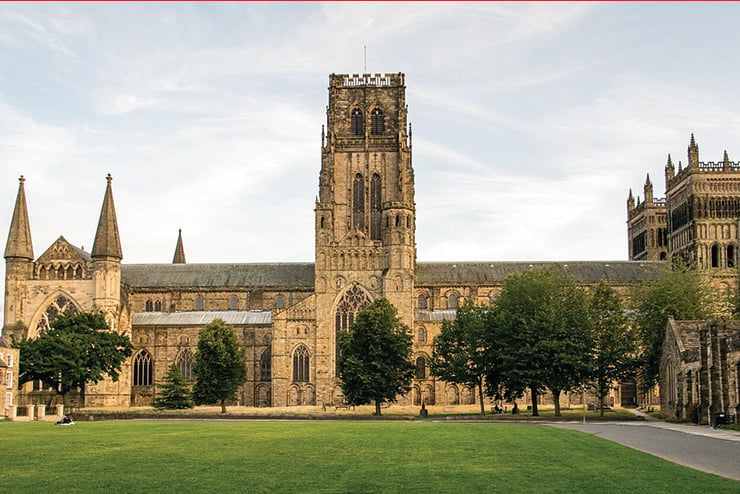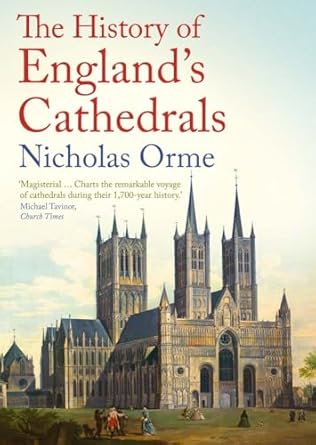The History of England’s Cathedrals
by Nicholas Orme
Yale University Press
320 pp., $30.00
As an amateur student of British history, my shelves creak with books about the Church in England, and the Church of England. Central in all these accounts, and unmissable in townscapes from Cornwall to Northumberland, are England’s world-renowned cathedrals: 43 magnificent Anglican edifices and 19 Catholic ones, built between Anglo-Saxon times and the 20th century.
In this update of a book originally published in 2017, the prolific medievalist Nicholas Orme has had the original idea of treating all these very different and already much-written-about buildings as a single class of cultural architecture, encapsulating the English religious imagination at its most expansive.
In Going to Church in Medieval England (2021), Orme wrote memorably about the experiences of parish-church attendees and clergy across England over the centuries of the Age of Faith. Now he focuses on grander buildings and statelier celebrations, showing how cathedrals emerged and evolved over 14 centuries, from their “Dark Ages” origins, through the Conquest and Reformation, to their half-life today as a splendid “heritage,” artefacts of a faith in which almost nobody in England now believes.
Orme, who apart from being an excellent historian is also an Anglican canon, is well qualified to place these monumental structures in their national, European, and Christian contexts. This is a book simultaneously deeply learned and piquantly evocative of an unrecoverable Europe.
Cathedrals can be overwhelming, which is unsurprising because they were always intended to swamp the senses. Even in an irreligious age, our first encounter with a cathedral can stop us in our tracks. This happened to me the first time I saw the Lincoln Cathedral, on a December day with the light failing and heavy snow rolling down from the Humber, and Durham Cathedral, even longer ago, beetling on its cliff above the Wear one blazing August afternoon. We can imagine how they must have looked to believers like Chaucer’s pilgrims, excitedly setting out from Southwark for Canterbury one April morning through the “sweete breeth” of spring and surrounded by the song of “smale foweles maken melodye.” After their arduous journey, their first glimpse of the Cathedral must have been like seeing the Celestial City.
Orme shows us how these magnificent buildings are managed as well as visualized—the complex interplays between bishops, canons, deans, and parish churches, the relationships between cathedrals and kings, and between cathedrals and “their” cities. Traditionally in England, only towns which held cathedrals were called cities, which led to anomalies. Until the creation of the Diocese of Birmingham in 1905, booming Birmingham (whose population was between 125,000 and 250,000) was just a town, whereas sleepy Wells in Somerset (with a population of no more than 10,000) had been a city since 1175.
Cathedral terminology can be confusing, but the author makes sense of their administration as well as architecture—useful for anyone who gets his retrochoirs mixed up with his reredoses. Even those more accustomed to cathedrals are likely to find new information, such as when crypts started going out of fashion and cloisters came in, or the purposes of annuelers (priests who say annual or anniversary masses) and succentors (minor canons who sing the responses to precentors).
Readers learn too about the importance of some cathedrals to education as locations of schools and important book collections, and the evolution of music through encouragement of polyphonic singing and organ-playing. There were also less predictable uses—such as in 1141, when King Stephen used the Lincoln Cathedral as a base from which to bombard the nearby Angevin-held Castle (the cathedral’s Norman builders had always envisaged it might need to be defended in the case of a Saxon insurgency).
Later, cathedrals were often surrounded by walls and gates so they could be protected from rowdy citizens or thieves, with trusted clerics manning the gates, and sometimes small security forces answerable to the dean. In 1272, the cathedral at Norwich was set ablaze by the townsfolk and 13 people died. The remnants of old circumvallation still give some cathedral closes an air of slightly hushed seclusion, as if they exist at an angle to the rest of England.
Cathedrals have suffered ravages, from earthquakes and Viking attacks to civil war, and yet have somehow endured, soaring serenely above frenetic and materialist 21st-century streets, a constant reproach and reminder of a lost world of authority and belief. Not all cathedrals endured. Abercorn was an English bishopric west of Edinburgh in the late seventh century until the Picts defeated the Northumbrians at Nechtansmere in 685 and expelled all English. Between 672 and 1071, there was a cathedral at North Elmham in Norfolk, of which almost nothing remains, except a battered ninth-century censer, now in the British Museum. Between 909 and 1058, there was an episcopal see at Ramsbury in Wiltshire, now just a little market town. Selsey was the cathedral for the Sussex diocese, before the see was removed to Chichester by William the Conqueror. Lindisfarne was also the seat of a bishop, until the Vikings made it unsafe.
If Lindisfarne was too prominent for its own good, the same could be said for other cathedrals in later times. Bishops sometimes had difficult relations with monarchs, most infamously Thomas à Becket’s “turbulent” relations with Henry II, which culminated in his murder in the north transept of Canterbury Cathedral in 1170. Few bishops were that brave, but some did defy the crown when they felt the monarch was impinging on their liberties or prerogatives, such as their right to select their own clergy or offer sanctuary to fugitives. Some bishops also resisted Rome if they felt a pope was overreaching. Bishops like Osmund of Salisbury and Thomas Cantilupe of Hereford had such a reputation for goodness that they became the objects of local veneration (both were later canonized).
Bishops were nevertheless often seen in less flattering lights, as complacent or corrupt buttresses of secular powers. This was understandable, especially in hard times when episcopal privileges and the ostentatious richness of their cathedrals put into relief everyone else’s hardships. One 16th-century prior at Worcester Cathedral had a household of 21 servants, including seven grooms, a huntsman, and a gardener. Henry VIII sought to cement his controversial new church by building new cathedrals, and reforming preexisting fanes to magnify his personal and regal authority, meaning fewer masses and side altars, less ornamentation, and much more preaching.
But the iconoclasm of his reign and even that of his severer son, Edward VI, did not go far enough for the Puritans, who increasingly saw cathedrals as not just scripturally unwarranted but symbols of worldly injustice. A 1571 Puritan pamphlet dubbed cathedral deans “loitering lubbers,” and some bishops agreed with such assessments, like John Jewel of Salisbury who called cathedrals “dens of thieves.” Enthusiasts with ladders and hammers accordingly wreaked terrible damage on medieval cathedrals and destroyed countless works of religious art, and during the Civil Wars Roundheads notoriously stabled their horses under their vaulted roofs. Chester lost most of its nave, and Lichfield lost its spires.
The one type of cathedral ornamentation that flourished after the Reformation was that of funerary monuments, as the suppression of the monasteries left cathedrals as the best places to be buried. Consequently, some venerable cathedrals now feel rather empty inside, notwithstanding their impressive forms, with modern replacement artworks generally dwarfed by their superb architectural framing.
Even in times of peace, there were always arguments between “high” and “low” or Evangelical factions within cathedrals, with consequences not only on ritual, but also on cathedral furnishings and appearance. Well-meaning but heavy-handed Victorian “restorers” often demolished irreplaceable historical fabric to make cathedrals more compatible with 19th century bourgeois ideas and usages.
Cathedrals could be nests of intrigue and infighting, as so memorably satirized by Anthony Trollope in his Barsetshire stories, and some are still so. Seriocomic clerical spats enliven the worthy pages of the Anglican newspaper Church Times, which are almost amusing distractions from today’s endless and tedious arguments about Anglicanism’s “implicit whiteness” and links to slavery.
Perhaps what is most surprising about cathedrals is not that ancient foundations have somehow survived into our age, but that new ones were built relatively recently, long after the Christianizing tide had turned. Catholic cathedrals were to be expected, following the emancipatory acts of the 18th and 19th centuries and the advent of millions of Irish immigrants—but Anglican ones appeared too, either upgraded from parish churches, or wholly new ones, like Truro, Guildford, and Liverpool. Coventry, notoriously incendiarized by the Luftwaffe in 1940, arose again in daring new guise during the 1950s and 1960s.
It seems impossible now to imagine any other Anglican cathedrals being built. Those that do exist are punishingly expensive to maintain, even though they retain sizeable congregations and attract many tourists. Sometimes, they seem to be almost embarrassments to a Church hierarchy apparently more interested in earthly matters, including taking political stances likely only to further alienate their shrinking congregations.
Orme is more hopeful, still trusting in the “amazing generative force” of his faith. “To visit a cathedral,” he concludes, “is to become aware of something that transfigures human life and to take, from the past, a hope and a spur for the future.”


Leave a Reply